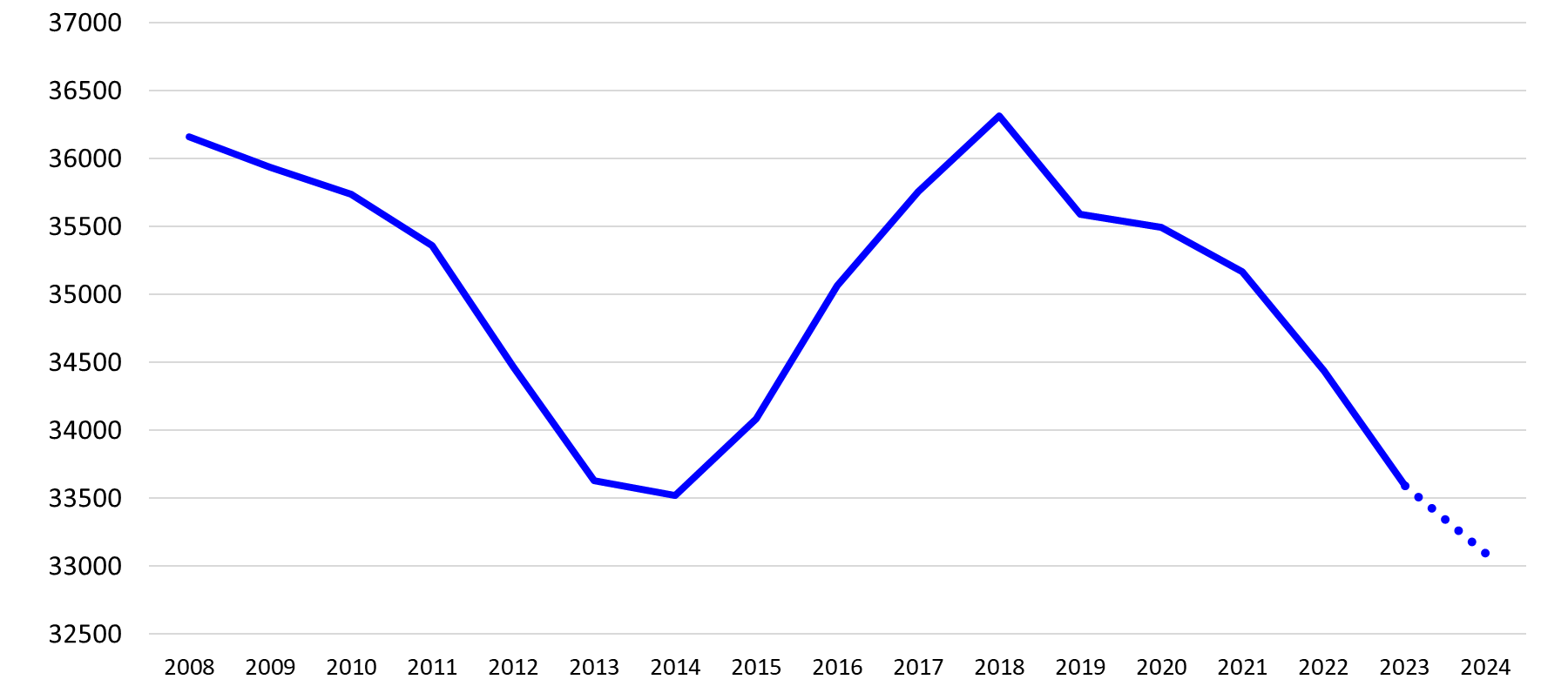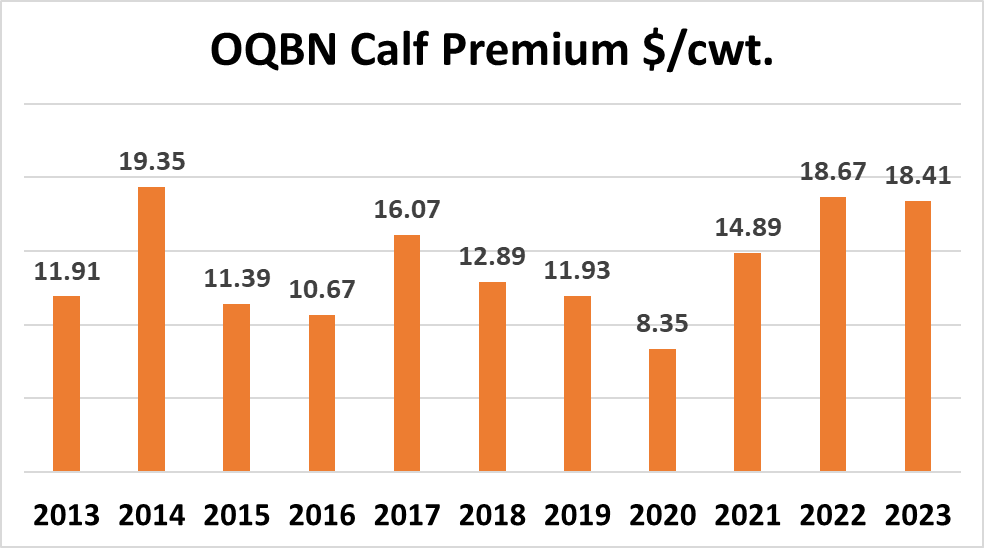Cow-Calf Corner | August 26, 2024
Feedlot Inventories Unchanged from Last Year
Derrell S. Peel, Oklahoma State University Extension Livestock Marketing Specialist
The latest USDA Cattle on Feed report pegged August 1 feedlot inventories at 11.1 million head, unchanged from one year ago. Because of the strong seasonal variation in feedlot inventories, a twelve-month moving average of feedlot inventories is the best means to see the actual trend in feedlot production. The moving average total of feedlot inventories peaked cyclically in September 2022 at 11.887 million head before declining to 11.548 million head in September 2023. Total feedlot placements have decreased by 1.3 percent in the last twelve months compared to the previous twelve-month period. However, in the last year, average feedlot inventories have increased to 11.636 million head. Feedlot inventories have risen countercyclically due to continued feeding of heifers and increased days on feed. Feedlots have slowed the feedlot turnover rate enough to keep average monthly inventories higher despite fewer cattle entering feedlots.
Feedlot placements in July were 105.8 percent of last year. The placement total was slightly higher than the average trade estimate. July marketings were 107.7 percent of one year ago, close to expectations. July 2024 was unusual with two extra business days in the month, meaning that daily average feedlot marketings were actually down by 2.1 percent year over year.
Current feedlot inventories mask the continued decline in feeder cattle in the U.S. Figure 1 shows the U.S. calf crop from 2008 to 2023 with a projected 2024 calf crop of 33.1 million head. At that level, the total calf crop is down 3.22 million head from the 2018 cyclical peak. The projected 2024 calf crop is the smallest total U.S. calf crop since about 1941 (based on estimated calf crop prior to 1960). This calf crop figure includes beef and dairy so straight-bred dairy as well as beef on dairy crossbred calves are included in this total calf crop.
Figure 1. U.S. calf crop numbers from 2008 to 2024.
Derrell Peel, OSU Extension livestock marketing specialist, explains why heifer retention could tighten up the market on SunUpTV from August 24, 2024.
Beef Quality Assurance in 2024
Mark Z. Johnson, Oklahoma State University Extension Beef Cattle Breeding Specialist
Beef Quality Assurance (BQA) is a nationally coordinated, state implemented program that provides systematic information to U.S. beef producers and beef consumers of how common-sense animal husbandry techniques can be coupled with scientific knowledge to raise cattle under optimum management and environmental conditions. BQA guidelines are designed to make certain all beef consumers have confidence in the entire beef industry. The BQA program is a producer-driven certification program designed to assure consumers that cattle from all industry segments (cow-calf, stocker, feedlot) are healthy, wholesome and have been produced under the best management practices in the cattle industry. When beef producers become BQA certified it sends a message to consumers that they are willing to take the management steps necessary to produce a quality product.
The BQA program is voluntary. There is no requirement for cow-calf or stocker operations to be certified unless they sell calves into a premium or branded program that includes BQA certification as a requirement. The Oklahoma Quality Beef Network (OQBN) does require producers to be BQA certified. Accordingly, while certification is not required for cow-calf or stocker operations, it can open the door to increased profit potential. Most packers require fed cattle they purchase be sourced from BQA certified operations, not surprisingly, nearly all feedlots are BQA certified.
The newest version of the BQA program focuses on the following management areas:
-
Behavior and Handling
-
Biosecurity
-
Herd Health Management
-
Transportation
-
Record Keeping
-
Nutrition
-
Environmental Quality Control Points
-
Worker Safety
-
Emergency Action Planning
Producers interested in becoming BQA certified have two options. The certifications process can be completed on-line at home where the process will include several modules followed by short quizzes. In-person certification is also available. The in-person training consists of a presentation followed by a short quiz. If you are interested in the in-person certification, contact your local OSU Extension office to find out when in-person certification is available in your area or visit the link below. Certification is valid for three years. At the end of three years, producers can re-certify by going through the same process as the initial certification. Dr Barry Whitworth is the Oklahoma BQA Coordinator.
References
Beef Quality Assurance Field Guide funded by the Beef Checkoff
OQBN Value Added Calf Sales Scheduled to Begin Fall 2024
Paul Vining, Oklahoma State University Department of Animal and Food Sciences, Oklahoma Quality Beef Network Coordinator
Oklahoma Quality Beef Network (OQBN) Vac-45 are scheduled to begin in November 2024. The OQBN Vac-45 Program is a calf preconditioning program designed to improve the health and performance of beef calves and therefore contributing to an increase in calf profitability.
Benefits of OQBN Vac-45 Certification:
- Improved Calf Health and Performance: University studies show that preconditioned calves gain between 0.40 to 0.77 pounds more per day than non-preconditioned calves during the feedlot phase. Preconditioned calves also demonstrate up to a 90% reduction in respiratory illnesses, which not only leads to healthier animals but also reduces the need for medical treatments. * Greater Marketability and Premiums: Healthy calves that perform better in the feedlot and require less medical intervention produce higher-quality carcasses. Thus, there are increased market premiums for OQBN-certified calves. In 2023, OQBN-certified calves received average premiums of $18.41 per hundredweight (cwt). Over the past 10 years, the average premium for certified calves has been $14.04/cwt, making OQBN certification a valuable investment for producers.
Figure 2. OQBN calf sales and premiums from 2013 to 2023.
What is Required for OQBN Certification?
Many producers are already implementing practices like those required for OQBN Vac-45 certification. The program involves preconditioning calves for 45 days post-weaning, including vaccinations, weaning management, and other health protocols designed to reduce stress and promote calf welfare.
Specific Requirements
OQBN Vac-45 Certification Requirements:
-
All calves must be:
-
Raised from the ranch of origin
-
Bull calves must be castrated and healed
-
Dehorned and healed
-
Weaned a minimum of 45 days
-
Vaccinated with 2 doses of a 5-way respiratory vaccine Vaccinated with 2 doses of at least a 7-way clostridial vaccine (blackleg) Vaccinated with 1 dose of Pasteurella/Haemolytica (shipping fever) * Identified with an OQBN program ear tag
-
Must follow one of three vaccination protocols
-
Branding (2-4 months of age) and Weaning
-
Preweaning (2 to 5 weeks preweaning) and Weaning
-
Weaning and Post-Weaning (2 to 4 weeks after weaning)
-
-
New for 2024: BigIron Online Auction Option
To facilitate the marketing of OQBN-certified calves, a new online auction opportunity is available through BigIron Auctions. This new feature offers producers a broader platform to market their preconditioned calves to a large audience of buyers.
How to Get Started:
-
Visit the OQBN Website: Learn more about the program by visiting the Oklahoma Quality Beef Network page on Oklahoma State University's website.
-
Order OQBN Ear Tags: Producers can register their calves and purchase OQBN ear tags online at OQBN Program Registration and Tag Purchase.
-
Contact Program Coordinator: For additional details, contact Paul Vining, OQBN Program Coordinator, at 405-744-4268 or via email.
OQBN provides a pathway for beef cattle producers to improve their operation's profitability while contributing to the production of healthy, high-quality beef for the market.
Paul Vining, Oklahoma Quality Beef Network coordinator, has updates for the OQBN program on SunUp TV from August 24, 2024.


